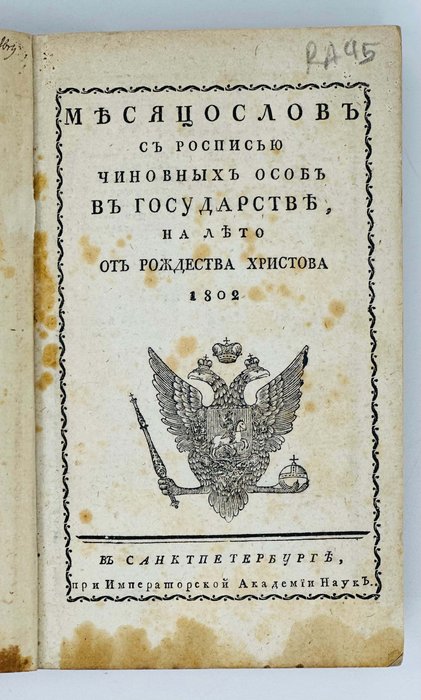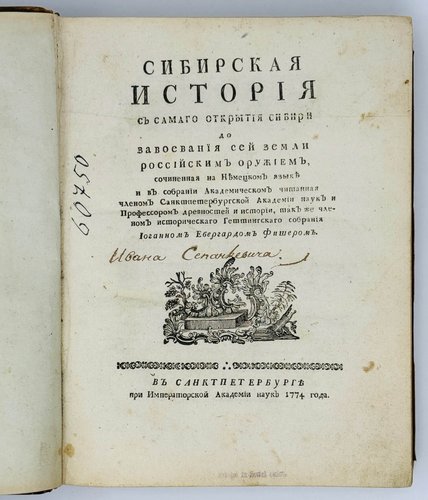





#RA45
[1801]
Octavo. xxiv, 514, viii pp. Title page with a woodcut vignette, Pp. 261-262 bound at pp. 513-514 (and vice versa), but all pages present. Original period marbled papered wrappers. Owner’s inscription in English on the inner side of the front wrapper, dated “Jan. 1802”. Wrappers slightly rubbed, minor staining of the title page, but overall a very good copy.
Very rare early edition of the “address-calendar” – an official directory of the government and public institutions of the Russian Empire, with names and ranks of all state officials. General “address calendars” covering the entire territory of the Russian Empire were published annually from 1765 until 1916, first by the Imperial Academy of Sciences, after 1867 – by the special department of the Governing Senate of the Russian Empire.
This is a rare copy of the first issue of the address calendar, resumed after a five-year prohibition to publish during the reign of Emperor Paul I of Russia (1796-1801). Shortly after his son, Alexander I, had become the new Emperor of Russia, a special decree was issued “to publish Mesiatseslov with the list of state officials exactly the same way as it used to be issued before 1797, with full names of the statesmen” (Imperial Decree from June 14, 1801). Worldcat indicates only one copy of this edition in the collection of early Russian address calendars (1765-1806) of the University of Göttingen Library.
The Mesiatseslov opens with a detailed calendar for 1802, a list of state and church holidays, and information about post office schedules and tariffs. The first part (pp. 1-232) contains lists of officials of all Imperial state bodies in Saint Petersburg: the State Council, Emperor’s Court and Cabinet (Office), commanders and officers of all regiments of the Emperor’s Life Guard (Preobrazhensky, Semenovsky, Izmailovsky, Cavalry, Cossacks, and others), the Governing Senate, the Holy Synod and all Imperial Collegiums/Ministries (Foreign Affairs – with the staff of all embassies and consulates abroad, Military, Admiralty, Medical, Berg/Mining, Commerce, Manufacture), supplemented with a list of foreign ambassadors and consuls in Russia. There are also lists of managers and staff of Russian state banks, post offices, Saint Petersburg wharf, State Mint, Police Department, Imperial Academy of Sciences and Academy of Arts, Moscow University, Free Economic Society, the Cadet Corps, State Archives, several educational and charity institutions, &c.
The second part (pp. 234-514) contains names and ranks of the state officials in all Russian provinces and governing territories (over 40), including Georgia, officially annexed by Russia in 1801. Eight pages (pp. 287-294) record the officials of the Irkutsk Gubernia (province), which then included the territories of Eastern Siberia, Yakutia, Chukotka and Kamchatka. The list starts with the military governor Nikolay Lebedev (1750-1813), his deputies and office, and staff of the criminal and civil courts. Then follow the directory of state officials (mayor, judge, treasurer and their associates) in the province’s main cities: Irkutsk, Verkheudinsk (since 1934 - Ulan-Ude), Nizhneudinsk, Kirensk, Nerchinsk, Barguzin (Buryatia), Yakutsk, Olyokminsk, Olensk (now Vilyuysk, Yakutia), Zhigansk (Yakutia), and Okhotsk (Khabarovsk Krai). Three directories record the officials of the cities which disappeared or were abandoned in the late 19th or 20th century: Zashiversk (a settlement on the Indigirka River, suffered during measles epidemics in the 19th century; abandoned since the 1880s), Gizhiginsk (was located on the coast of the Okhotsk Sea in modern-day Magadan Oblast of Russia, abandoned in the 1920s), and Nizhnekamchatsk (east coast of Kamchatka near the mouth of the Kamchatka river, abandoned in 1968). There is also a list of the officials responsible for the “border affairs” in Troitsko-Savsk (Kyakhta) and the settlement of the lands beyond Lake Baikal. The alphabetical index at the rear (pp. i-viii) lists the names of provinces and territories, principal cities and state institutions.
The title page is decorated with a woodcut vignette with the coat of arms of the Russian Empire; the inner side of the front wrapper is inscribed by the owner, who apparently acquired the Mesiatseslov shortly after it had been printed in January 1802. Overall a very good copy of this rare Russian directory of state officials, preserved in its original state.













